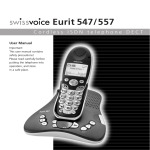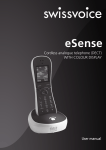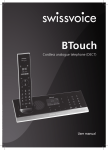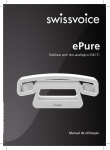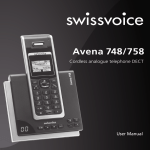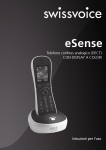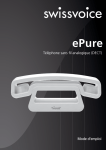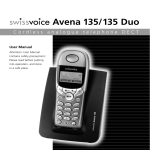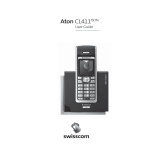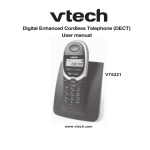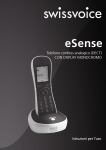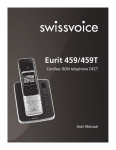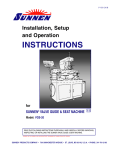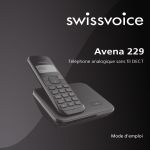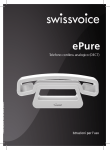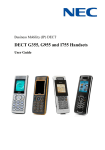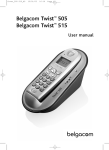Download Avena 116/116 Duo
Transcript
Avena 116/116 Duo Cordless analogue telephone DECT User Manual Important: This user manual contains safety precautions! Please read carefully before putting the telephone into operation, and store in a safe place. Safety precautions This DECT cordless telephone is designed for transmitting voice calls over the analogue telephone network. Any other use whatsoever is not permitted and is regarded as in violation of the provisions. The user manual with safety precautions is a part of the product package and must be passed on to the new owner on reselling. Caution! Use only approved rechargeable nickel-metal-hydride (Ni-MH AAA 600mAh) batteries. Using other rechargeable batteries or non-rechargeable batteries/primary cells can be dangerous and may cause malfunctions in or damage to the telephone. The manufacturer accepts no liability in this event. Refer to chapter "Putting the handset into operation" for instructions on how to properly insert the batteries. Please note that the ringtone for incoming calls as well as alert tones, are also emitted on the handset. Do not therefore hold the handset close to your ear while one of these functions is on, otherwise your hearing may be affected. Please note: ➭ Do not immerse batteries in water or throw in the fire. ➭ Rechargeable batteries can become warm while recharging. This is a normal occurrence and is not dangerous. ➭ Do not use any other type of charging unit since this may damage the battery cells. ➭ Before using the telephone, wearers of hearing aids should note that radio signals can be picked up by the hearing aid and cause an unpleasant buzzing noise. ➭ Do not use your DECT cordless telephone in environments at risk from explosion (e.g. paintworks, petrol stations etc.) ➭ Do not position the base station / charging bay in bathrooms or showers. ➭ The radio signals may affect the functioning of medical equipment. ➭ In the event of a power cut or if the batteries are discharged, your DECT cordless telephone will not function! ➭ The handset must not be charged up without battery cells or the battery cover. ➭ Never touch exposed contacts! ➭ Use only the supplied SNG 04-ea power pack plug for the base station and charging unit. Disposal Please dispose of the batteries, base station, handset, charging unit and power pack in an ecological manner. Contents Your Avena 116 /116 Duo is designed to be connected to an analogue telephone network. This telephone is available either with one handset (Avena 116) or as a set with two handsets and a charging bay (Avena 116 Duo). Safety precautions Setting up the telephone……………………………………………………………………3 Package contents …………………………………………………………………………3 Location ……………………………………………………………………………………3 Secure telephone conversations …………………………………………………………4 Setting up the base station / charging bay ………………………………………………4 Wall mounting ……………………………………………………………………………5 Connecting the telephone ………………………………………………………………6 Removing the cords ………………………………………………………………………7 Putting the handset into operation ………………………………………………………8 Displays, keys, symbols …………………………………………………………………11 Selection of dialling mode ………………………………………………………………14 Key lock on/off ……………………………………………………………………………15 Group call (paging) ………………………………………………………………………15 20401551en_ba_a0 Telephoning …………………………………………………………………………………16 Internal and external calls ………………………………………………………………16 Accepting a call …………………………………………………………………………17 Transfer an external call internally ………………………………………………………18 Redial ……………………………………………………………………………………19 Network mailbox …………………………………………………………………………19 Dialling from the call list* ………………………………………………………………20 Setting the handset volume ……………………………………………………………21 Muting the handset ……………………………………………………………………21 * Only in networks that enable caller ID (Calling Line Identification Presentation, CLIP). Contact your network operator to find out whether this service is supported. 1 Contents Telephone settings…………………………………………………………………………22 Setting the ring tone volume …………………………………………………………22 Setting the ring tone melody …………………………………………………………22 Speed dialling …………………………………………………………………………23 Direct call (baby call) …………………………………………………………………24 Setting the flash time …………………………………………………………………25 Restoring default settings ………………………………………………………………25 Changing the PIN ………………………………………………………………………26 Activate / de-activate key clicks …………………………………………………………26 Appendix ……………………………………………………………………………………27 Technical Data ……………………………………………………………………………27 Approval …………………………………………………………………………………28 CE certification …………………………………………………………………………28 Warranty conditions ……………………………………………………………………28 Warranty Certificate ………………………………………………………………………29 20401551en_ba_a0 Declaration of Conformity ………………………………………………………………31 2 Setting up the telephone Package contents The package contains the following items: Avena 116 ➭ 1 Base station ➭ 1 Connection cord ➭ 1 Power pack plug Typ SNG 04-ea ➭ 1 Handset ➭ 2 Dowels / 2 screws ➭ 2 Rechargeable batteries ➭ 1 User manual Avena 116 Duo ➭ 1 Base station ➭ 1 Charging bay ➭ 1 Connection cord ➭ 2 Power packs plug Typ SNG 04-ea ➭ 2 Handsets ➭ 2 Dowels / 2 screws ➭ 4 Rechargeable batteries ➭ 1 User manual 20401551en_ba_a0 Location To obtain the best possible range, we recommend positioning the telephone in a location central to your sphere of activity. Avoid positioning the telephone in niches, recesses and behind steel doors. The maximum range between the base station and handset is approximately 300 meters. Depending on the surrounding conditions as well as spatial and structural factors, the range may be smaller. The indoor range is normally smaller than outdoors. Depending on the structural surroundings, radio dead spots may occur even within the range due to digital transmission in the frequency range used. In this case the transmission quality may be reduced through the increased incidence of short breaks in transmission. Normal transmission quality will be resumed if you move slightly out of the radio dead spot. When the range is exceeded, the connection will be broken unless you move back into range within ten seconds. To avoid radio signal interference from other electronic equipment, we recommend that the base station / charging bay and handset are situated at the greatest possible distance (minimum 1 meter) from other equipment. 3 Setting up the telephone Secure telephone conversations While in a telephone conversation, the base station and handset(s) are connected through a radio channel. The base station is the interface between the telephone network and the handset. To prevent people from tapping your telephone calls or making phonecalls on your expense, the base station and handset(s) are continuously exchanging identification codes. In case of non-matching identification codes, a connection with foreign handsets will not be set up. Setting up the base station / charging bay ➭ Do not expose the base station / charging bay to direct sunlight. Protect the base station / charging bay against moisture. Do not position the telephone in rooms exposed to condensation, corrosive steam or excessive dust. Condensation can occur in cellars, garages, conservatories or sheds. The ambient temperature must be between 5 °C and 40 °C. Position the base station / charging bay in a clean, dry and well-aired location. Choose a place which is stable, even and not subject to vibrations. 20401551en_ba_a0 To avoid mutual interference, do not position the base station / charging bay in the immediate vicinity of electronic equipment such as hi-fi systems, office equipment or microwave ovens. Avoid positioning the telephone near heat sources such as heating elements or near obstacles such as metal doors, thick walls, niches and cupboards. The base station / charging bay does not have a mains switch. For this reason the socket to which it is connected must be easy to access. 4 Setting up the telephone Wall mounting Your Avena 116 /116 Duo is suitable for wall-mounting. Two screws and two dowels are provided for this purpose. Place the dowels vertically at a distance of 90 mm from each other and insert the screws. Leave approximately 3 mm space between the screw head and the wall. Hang the base station on the screws and connect it to the power supply and telephone connection. 90 mm 3 20401551en_ba_a0 Note Please remember: • The 230 V and telephone connection should be within range of the cable provided. • Please also note that the base station must not be mounted in the opening area of doors and windows: Danger of damage! • Caution: Take care not to damage leads in the wall! 5 Setting up the telephone Connecting the telephone Before you can start using your telephone you must plug in the telephone connection cords and the mains cable. Safety note Use only the SNG 04-ea power pack provided for the base station / charging bay! ➀ Telephone connection cord The telephone connection cord has two different plugs. Insert the smaller plug in the socket marked with the telephone symbol, and fit the cord into the corresponding cable groove. Insert the larger plug in your telephone connection socket. ➁ Mains cable 20401551en_ba_a0 First, insert the mains cable in the socket marked with the mains plug symbol on the base of the base station / charging bay, and fit the cable in the corresponding cable groove. Then insert the mains plug in the 230 V socket. Note Socket for mains cable ➁ Socket for telephone connection cord ➀ Your telephone will not function if the mains plug is not plugged in or during a power cut. 6 Setting up the telephone Removing the cords First unplug the mains plug from the 230 V socket and the plug from the telephone connection socket. 20401551en_ba_a0 To release the cord, use a ballpoint pen or similar object to press the holding hook towards the plug and simultaneously pull the plug out along with the cord. 7 Setting up the telephone Putting the handset into operation Your handset will be ready for operation (for making or accepting calls) only once the battery has been charged for the first time. Inserting the rechargeable batteries The bottom of the handset contains a battery compartment for housing two type AAA batteries (microcells). Removing the battery compartment cover: Slide the battery compartment cover downwards (approx. 3 mm) and lift. Inserting the two rechargeable batteries (note the polarity!): 20401551en_ba_a0 Insert the batteries in the battery compartment. Make sure the polarity is correct. Make sure to insert the batteries so that the flat end of the battery (the negative side) connects to the spring contact. The handset will not function if the batteries are incorrectly inserted. This may result in damage. Replace the compartment cover by placing it approximately 3 mm offset and slide it upwards until it clicks into place. 8 Setting up the telephone Charging the batteries The batteries are not yet charged when you first unpack the telephone. To charge the batteries, place the handset on the base station / charging bay. The flashing battery symbol on the handset signals the charging procedure. The batteries will take around 14 hours to charge up. Note • Do note place the handset in the charging bay if the batteries have not been fitted. • Do not use strange charging bays, the batteries can be damaged. The following symbols indicate the charging status on the handset display: D C A Charging status “empty” Charging status “1/2 ” Charging status “full” Once the new batteries have been inserted, the display (1/2, full) on the handset indicates the actual charging status only after a complete charging procedure. Insert the plug into your telephone connection socket once the battery symbol has stopped flashing. 20401551en_ba_a0 Your telephone is now ready to use. Important! Please note: The first time you insert the batteries, the battery display will indicate the correct information on the charging status only after a complete charging cycle. Use only NiMH rechargeable batteries. Never use disposable batteries/primary cells. ! 9 Setting up the telephone Note You can replace the handset in the base station / charging bay after every call. Charging is electronically controlled to ensure optimal charging of batteries in different charge states. Avoid removing the batteries from the handset for no good reason, since this affects the optimum charging cycle. You can telephone for up to 10 hours with fully charged batteries. 20401551en_ba_a0 If the battery charge status has reached its lower limit, the battery symbol (D) flashes in the display and a warning signal is heard. You have 10 minutes of talk time left. 10 Setting up the telephone Displays, keys, symbols Displays The display gives you information on the current status of your telephone. The «standby indicator» shown below shows you your handset is ready for use. The symbols in the upper row of the display have the following meaning: R Ó M G S A 888888888888 R Ó M G Í K A 20401551en_ba_a0 Note The symbol is permanently lit if a connection to the base station exists. The symbol flashes to indicate that the handset is near the limit of the base station range. You have pressed the talk key. You have pressed the “mute” key: the microphone is off. You have switched off the ring tone. You have activated the key lock. Shows new entries in the call list*. Shows the battery charge status. Two segments indicate full or almost full batteries. If no segment is shown or the empty frame is flashing, your handset should be returned to the base station / charging bay for charging. At the end of a call the duration of the conversation is shown on the display. * Only in networks that enable caller ID (Calling Line Identification Presentation, CLIP). Contact your network operator to find out whether this service is supported. 11 Setting up the telephone Handset keys Open call list*, press key several times to scroll down. Previous called number(s), press to scroll through this redial list. Performs different functions depending on the context. ➮ Deletes the last character or number of an entry in the display. ➮ Press this key to return to standby mode. If you are editing an entry in the speed-dial memory, in the call or redial list*, you can hold down this key to delete the entry. ➮ Press this key to switch the microphone off during a call. Open speed-dial memory, press key several times to scroll down. Enquiry call key with flash function. Avena 116 Duo: Long-press: Call the other handset (internal call). Programming key to start and end programming. Talk key. Corresponds to “lift/replace handset” on a corded telephone. … Numerical keys for dialling telephone numbers. ABC printing (Vanity numbers) on the housing. “0 ” key: when entering a number, hold this key down to generate a dialling pause between two digits. Long-press: the network mailbox number is dialled directly. 20401551en_ba_a0 Hash key (or pound key) for entering the “hash” symbol. The sequence 34# appears as follows: 34 o . In standby mode, hold this key down to activate/deactivate the key lock. Asterisk key (or star key) for entering the “asterisk” symbol. 34 o . In standby mode, hold this key down to activate/deactivate the ring tone. * Only in networks that enable caller ID (Calling Line Identification Presentation, CLIP). Contact your network operator to find out whether this service is supported. 12 Setting up the telephone In programming mode: Direct call on/off. Set handset volume. Set ring tone melody. Set ring tone volume. Handset: Earpiece Display Delete/cancel key Call list* Speed-dial key Talk key Redial key Enquiry key Programming key 20401551en_ba_a0 Numerical keys Microphone * Only in networks that enable caller ID (Calling Line Identification Presentation, CLIP). Contact your network operator to find out whether this service is supported. 13 Setting up the telephone Base station keys Call key on the base station to activate a paging call. Paging key Charging cradle for the handset Selection of dialling mode The transmission of the phone number can take place either with tones or impulses. The presetting of your Avena 116 / Duo is the tone mode (DTMF). You may change this. Press the programming key. 20401551en_ba_a0 Press the key with the star-symbol. Press "1" to select the pulse-mode or "2" to select the tone-mode. Finish the programming with "P". 14 Setting up the telephone Key lock on/off If you want to carry the handset around in your pocket, activate the key lock. This prevents you inadvertently dialling a number. During incoming calls the key lock is deactivated for the duration of the call. Key lock on Hold down the hash key for about 2 seconds. The display shows the key symbol Í . Key lock off Hold down the hash key for about 2 seconds. Note You cannot make outgoing calls while the key lock is on. The display shows the Í symbol to indicate that the key lock has been activated. Group call (paging) If you have misplaced your handset(s), you can send to all logged on and accessible handsets a group call. All logged on and accessible handsets then ring for 60 seconds. Paging call (page) from the base station: 20401551en_ba_a0 Press the call key on the base station. End call Press the talk key on the handset. 15 Telephoning Internal and external calls One or two handsets are logged on to the base station. In case you purchased the Avena 116 Duo, you have two handsets. You can make internal calls between those two handsets. Internal calls Press the -key for approx. 2 seconds to call the other handset. To end this internal call: Press the talk-key. External calls Press the talk key. Z Enter the required telephone number. This number will then be dialled. To end this external call: Press the talk-key. 20401551en_ba_a0 Note You may also make external calls by using predialling: enter the telephone number, use the key to make any corrections and press the talk-key. The telephone number will then be dialled. To enter a dialling pause between two digits press "0" for approx. 2 seconds. Your Avena 116/116 Duo supports 18-digit telephone numbers. 16 Telephoning Accepting a call Calls are signalled acoustically as well as optically in the handset display. ➭ The caller’s number is displayed if your network operator supports the CLIP service. ➭ The caller’s number is not displayed if the caller has withheld his number i.e. if he has suppressed transmission of his number, or if this is not technically possible. Accepting a call Press the talk key. H You can set the volume and melody of the ring tone. 20401551en_ba_a0 Note Conduct your call. 17 Telephoning Transfer an external call internally You are in an external telephone conversation and you want to transfer this call to the other handset. H You are conducting an external telephone call. Press the -key for approx. 2 seconds. The external call is put on hold and the second handset will start to ring. You can now talk to the other internal party. Press the talk-key to transfer the call to the internal party. When the internal party ends the call, you are reconnected back to the external party. If the internal party does not answer, press the -key for approx. 2 seconds to return to the external party again. Brokering between the two calls -key for approx. 2 seconds. You are connected to the other party. 20401551en_ba_a0 Press the 18 Telephoning Redial The last 10 dialled numbers are saved under the redial key. Open the redial list. The last dialled number is displayed. Press this redial key again to scroll through the list. Press the -key to exit the redial list. Press the -key for approx. 2 seconds to delete the currently displayed entry from the list. Press the talk-key to dial the corresponding telephone number. Network mailbox Some providers offer the service "Network Mailbox" (voice mailbox), acting as an automatic answering machine. You can very easily access to your mailbox by programming the network mailbox access number on key “1”. Programming the access number Press the programming key. Press 8. Z Enter your four-digit PIN (at the delivery the PIN code is set to “0000”). Press the programming key. Z Enter the telephone number. 20401551en_ba_a0 Press the programming key. 19 Telephoning Listen to messages in the network mailbox Hold down key 1 for about 2 seconds. The connection to your network mailbox is automatically established. Dialling from the call list If your network operator supports caller ID (CLIP), numbers (up to 18 digits) of unanswered calls are saved in the caller list. The list can hold up to 20 entries. If the list is full, the oldest entry is deleted and the newest is put first in the list. The display alerts K you to new incoming, unanswered calls. Selecting a number from the call list Press the call list key. The latest entry is shown. Press the talk key. The displayed number is dialled. or… Scroll through the call list to view unanswered call numbers and, if necessary, call them back. Press once: returns you to standby mode. Hold down: the displayed entry is deleted and the next entry is shown. 20401551en_ba_a0 Deleting the entire call list Press the following keys in consecutive order: 20 . Telephoning Setting the handset volume The handset volume can be set and saved at any of three levels. Press the programming key. Press 4. The current volume setting is displayed (e.g. “2/3 ” is the middle volume 2 of 3). Z Use numerical keys 1 to 3 to set the preferred volume. Press the programming key to save the setting. Muting the handset If you do not want your call partner to hear what you are saying to another person in the room, you can temporarily mute your handset. H You are conducting a call. Press the C key. The display shows M. The call is put «on hold», and the call partner cannot hear you. 20401551en_ba_a0 Press the C key. Your call partner can hear you again. 21 Telephone settings Setting the ring tone volume The ring tone volume can be set and saved at any of three levels. Press the programming key. Press 6. The current volume setting is displayed (e.g. “2/3 ” is the middle volume 2 of 3). Z Use numerical keys 1 to 3 to set the preferred volume. Press the programming key to save the setting. You can activate and deactivate the ring tone by holding down the key (for approximately 2 seconds). If the ring tone is off, the display shows the symbol Setting the ring tone melody You have a choice of six different melodies. Press the programming key. Press 5. The current setting is displayed (e.g. “2/6 ” is the second of 6 settings). 20401551en_ba_a0 Z Use numerical keys 1 to 6 to set the preferred melody. Press the programming key to save the setting. 22 G. Telephone settings Speed dialling Your Avena 116/116 Duo can store 10 speed-dial numbers. Selecting speed dialling Press the speed-dial key. The first entry is displayed. Scroll through the speed-dial list by pressing the speed-dial key as often as required or use numerical keys 1 to 9 to select an entry. Press the talk key to dial the number. To abort the function without dialling, press . Entering/editing speed-dial numbers Press the programming key. Press the speed-dial key. The first entry is displayed (0). Press the speed-dial key as often as required to scroll through the list. A saved number is displayed. Delete individual digits backwards by pressing the key. Hold down the key to delete the entire number. You can add a dialling pause between two digits by holding down the «0» key. Z Enter the telephone number. 20401551en_ba_a0 Press the programming key to save the setting. Deleting the entire speed-dial list Press the following keys in consecutive order: 23 . Telephone settings Direct call (baby call) With direct call, you can program a number which can be directly dialled when any key (except the programming key) is pressed. Activating/deactivating direct call Press the programming key. Press 2. Z Enter your four-digit PIN. Press the programming key. If direct call was deactivated, this activates it. If direct call was activated, this deactivates it. Press the programming key to save the setting. If direct call is activated, the direct call number is displayed in the handset. Entering/editing the direct call number Press the programming key. Press 3. Z Enter your four-digit PIN. Press the programming key. 20401551en_ba_a0 A saved number is displayed. Delete individual digits backwards by pressing the key. Hold down the key to delete the entire number. You can add a dialling pause between two digits by holding down the «0» key. Z Enter the number which is to act as the direct call number. Press the programming key to save the setting. 24 Telephone settings Setting the flash time You can set the flash time between 80 ms and 600 ms. Press the programming key. Press the enquiry key and key 1. The flash time is set to 80 ms. or for example Press the enquiry key and key 5. The flash time is set to 250 ms. Possible settings: 1 = 80 ms; 2 = 100 ms; 3 = 120 ms; 4 = 180 ms; 5 = 250 ms; 6 = 300 ms; 7 = 600 ms Press the programming key to save the setting. Refer to your PBX user manual when setting the flash time. Restoring default settings This procedure resets all the personal preferences you have programmed and restores the telephone to default mode. Press the programming key. Press 9. 20401551en_ba_a0 Z Enter your PIN. Press the programming key to save the setting. 25 Telephone settings Changing the PIN The PIN is a four-digit password to protect the base station and handsets against unauthorised access. The telephone is delivered with the system PIN set to «0000». Press the programming key. Press 1. Z Enter the old four-digit PIN (default setting “0000 ”). Press the programming key. Z Enter a new four-digit PIN. Press the programming key. Z Enter the new PIN again (security measure). Press the programming key to save the setting. Activate / de-activate key clicks Press the programming key. Press to switch the key clicks setting on/off. 20401551en_ba_a0 Press the programming key to complete the sequence. 26 Appendix Technical Data Standard: DECT Frequencies: 1880 MHz bis 1900 MHz Permissible ambient conditions for Base station /charging bay operation: 5 °C to 40 °C 20 % to 70 % relative humidity Duplex process: Time multiplex, 10ms frame length Permissible storage temperature: 0 °C to + 60 °C Channel spacing: 1728 kHz Dialling procedure: DTMF / Impuls Bit rate: 1152 kBit /s R key function: flash 80, 100, 120, 180, 250, 300, 600 ms Number of channels: 120 duplex channels Modulation: GFSK Speech coding: 32 kBit /s Transmitting power: 10 mW (average per channel) Range: up to 300 meters outdoors, up to 50 meters indoors Base station /charging bay power supply: 220/230 V /50 Hz (power pack) Base station /charging bay power supply: approx.1.8 VA 20401551en_ba_a0 Handsets operating time: standby / talk time 600 mAh = approx.100h / approx.10h Battery charging time: approx.14 hours Base station dimensions: Width/height/depth = 115 x 100 x 70 mm Handsets dimensions: Length/width/height = 149 x 51 x 25 mm Charging bay dimensions: Length/height/depth = 65 x 60 x 70 mm Base station weight: 152 g Weight of a handset: 102 g (without batteries), 124 g (with batteries) Charging bay weight: 44 g Length of connection cord: 3 m Length of power cord: 3 m Power pack: Euro Permissible ambient conditions for handsets operation: 5 ° C to 40 ° C 27 Appendix Approval This DECT cordless telephone complies with the basic requirements contained in the R&TTE Guidelines 99/5/EC and is suitable for connection and operation in the member state indicated on the base station and/or packaging. CE certification This telephone complies with the requirements of EU Guidelines Directive 99/5/EC on radio equipment and telecommunications terminal equipment and the mutual recognition of their conformity. The CE symbol confirms the conformity of the telephone with the above guidelines. 20401551en_ba_a0 Warranty conditions Your telephone is subject to a guarantee from the date of purchase in accordance with the legal provisions of the country in which the telephone was purchased. As evidence of the date of purchase, please keep the receipt or the warranty card completed by the retailer. All defects attributable to material and manufacturing faults will be corrected free of charge within the warranty period, either by repairing or replacing the defective equipment. The warranty does not cover expendable materials (battery cells), defects which affect the value or use of the equipment only insignificantly, and damage caused by incorrect use, ordinary wear and tear, or manipulation by third parties. This warranty does not cover consequential damage caused by the use, failure or defectiveness of the product. In particular, no liability whatsoever is accepted for damage to property and pecuniary loss. To claim under this warranty, please contact the retailer where you purchased your telephone. 28 Warranty Certificate Warranty Certificate Garantieschein, Bon de garantie, Certificato di garanzia, Garantiebewijs, Takuutodistus, Garantibevis, Garantisedel, Garantibevis, Certificado de Garantía, Talão de garantia device type: (Gerätetyp, type d’appareil, tipo di apparecchio, toesteltype, laitetyyppi, maskintype, apparattyp, apparattype, modelo del aparato, modelo do aparelho): serial number: (Seriennummer, numéro de série, numero di serie, serienummer, sarjanumero, serienummer, serienummer, serienummer, número de serie, número de série): dealer’s stamp: (Händlerstempel, sceau du vendeur, timbro del rivenditore, stempel van de dealer, kauppiaan leima, forhandlerens stempel, försäljarens stämpel, forhandlerstempel, sello del comerciante. carimbo do vendedor): dealer’s signature: (Unterschrift des Händlers, signature du vendeur, firma del rivenditore, handtekening van de dealer, kauppiaan allekirjoitus, forhandlerens underskrift, försäljarens underskrift, forhandlers underskrift, firma del comerciante, assinatura do vendedor): date of purchase: (Kaufdatum, date d’achat, data d’acquisto, datum van aankoop, ostopäiväys, kjøpsdato, datum för köpet, salgsdato, fecha de adquisición, data de compra): 29 ✄ Konformitätserklärung Declaration of Conformity Déclaration de Conformité Wir: We: Nous: Adresse: Address: Adresse: Swissvoice AG Fabrikstrasse 8 CH-4614 Hägendorf Switzerland erklären, dass das Produkt / declare that the product / déclarons que le produit: Type: DECT Cordless Telephone (Basisstation, Ladestation und Handgeräte / Base station, charging bay and handsets / Station de base, station de recharge et combinés) Model: Avena 116/116 Duo die grundlegenden Anforderungen gemäss Artikel 3 der nachstehenden EU-Richtlinie erfüllt: meets the essential requirements according to article 3 of the following EC-Directive: est conforme aux exigences essentielles de l’article 3 de la Directive CE: Richtlinie 1999/5/EG des Europäischen Parlaments und des Rates vom 9. März 1999 über Funkanlagen und Telekommunikationsendeinrichtungen und die gegenseitige Anerkennung ihrer Konformität Directive 1999/5/EC of the European Parliament and of the Council of 9 March 1999 on radio equipment and telecommunications terminal equipment and the mutual recognition of their conformity Directive 1999/5/CE du Parlement Européen et du Conseil du 9 mars 1999 concernant les équipements hertziens et les équipements terminaux de télécommunications et la reconnaissance mutuelle de leur conformité und dass die folgenden harmonisierten Normen angewandt wurden: and that the following harmonised standards have been applied: et que les standards harmonisés suivants ont été appliqués: EN 60950, EN 301489-6, EN 301406 Hägendorf, 10. 12. 2003 A. Zipp i.V. B. Gfeller Internet: www.swissvoice.net © Swissvoice AG 2003 All rights as well as delivery possibilities and technical changes reserved. 20401551en_ba_000_a0 SV 20401551




































